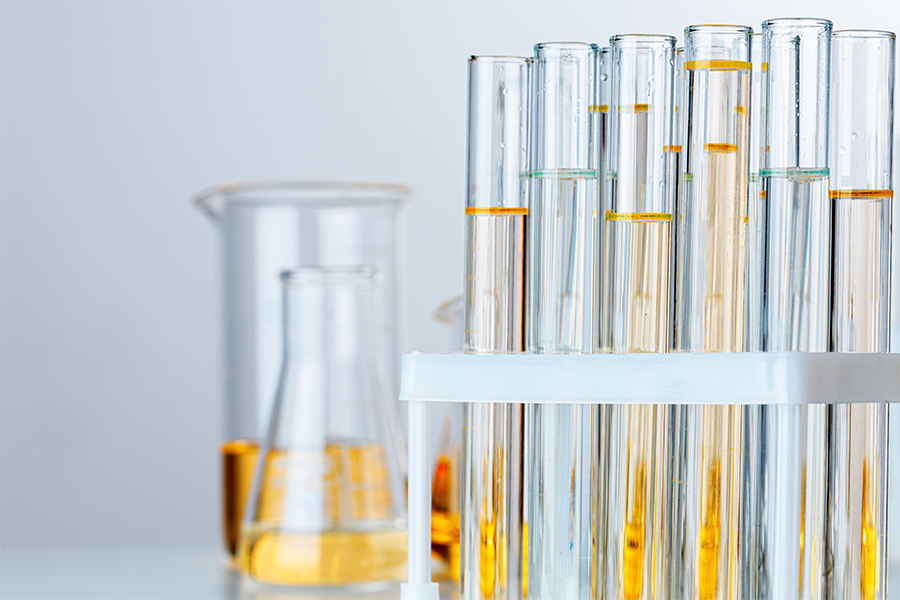Amino acid purification with activated carbon
In the production of amino acids, high standards of purity are essential. DESOTEC has extensive experience of working with clients in the chemical sector, finding the best possible purification solutions for each unique application.
Market and drivers
Amino acids are used in the feed, food, and pharma, healthcare and cosmetics markets. The food sector is taking over from animal feed as the biggest market.
For feed, amino acid additives reduce costs, improve efficiency, and enhance animal growth. L-lysine, DL-methionine, L-threonine, and L-tryptophan are commonly used in this sector.
For food, they are used as preservatives or flavour enhancers. They may also be added to ensure sufficient intake of essential amino acids, which the human body cannot produce itself. L-glutamic acid, L-aspartic acid, L-phenylalanine are widely used.
In healthcare, they are used to treat sleep disorders and digestive problems, or as drug precursors for a range of other pharmaceuticals. In cosmetics, they are found in moisturisers.
The global amino acid market was valued at between 21 and 25 billion Euros in 2020, with a projected annual growth rate of 5-7%.
Some 8 million tonnes of amino acids are produced annually. The non-essential L-glutamic acid (used for food seasoning and as a feed additive) and the essential L-lysine (used as a feed additive and as a dietary supplement) have the largest production volumes.


Amino acid production
There are several ways to produce amino acids. Biotechnological processes, namely fermentation and enzymatic catalysis, are growing in importance, while extraction and chemical synthesis are waning.
For amino acid production via fermentation, agricultural by-products are generally used as feedstock. Plants such as soybean, wheat, corn, potato, and pea, processed using biotechnology, account for most global revenue. Of the most common amino acids, L-glutamate and L-lysine are generally produced through fermentation of plant-based feedstock.
For amino acids via extraction, animal sources are most common. Cysteine and tyrosine are produced in this way.
DL-methionine is still mainly oil-based and usually produced through chemical synthesis.
Purification challenges
Clearly, given the sectors concerned, it is crucial that amino acids meet very high standards of purity and quality.
The most common impurities that require treatment are organic nitrogen molecules, detected as colour and measured by UV transmission. They can be caused by variations in feedstock or process parameters.
Purification may also be necessary to:
- Improve the crystallisation process
- Improve yields through reducing losses
- Remove toxic or foaming compounds before fermentation
- Improve the fermentation process.
Purification technologies
Activated carbon can be used to remove unwanted molecules from amino acids, during production and/or as a polishing step. There are two forms: powdered (PAC), and granular (GAC).
PAC is added to batches of amino acid solution to adsorb the contaminants and then filtered out. However, PAC cannot be reactivated and thus creates a waste stream. Furthermore, consumption is usually two-three times higher than for granular activated carbon (GAC).
Therefore, switching to a continuous process using GAC can make sense for clients. GAC is contained in filter units and removes impurities through adsorption onto the filter bed. Once saturated, the carbon can usually be reactivated, improving its cost-effectiveness and sustainability.
However, amino acid manufacturers have high standards in terms of product quality and prefer to reuse their own reactivated carbon instead of partaking in a general pool. For major customers, we can offer dedicated reactivation services, providing sole use and reuse of their own activated carbon.
Activated carbon filtration can also treat vented air emissions and wastewater coming from the amino acid production process.
Case studies: Amino acid purification in practice
We have a long-term partnership with a major European manufacturer of an essential amino acid. Its product still contains molecules that give it a slight colour and other impurities that reduce the quality. There are multiple filters in series on site to treat the flow of 20 – 40 m³/h. To achieve optimal purification, the process is carried out at a higher temperature and low pH.
We are cooperating with several other amino acid manufacturers in Europe. One of them is Evonik, which is the largest global producer of methionine. The methionine product solution is treated in GAC filters to increase the UV transmittance and remove side components. In production trials in Antwerp, DESOTEC’s renewable granular activated carbons (GAC) replaced coal-based GAC while maintaining excellent performance. The switch to renewable GAC was completed successfully without any drop in performance. Laboratory tests showed further the feasibility of GAC reactivation, which will soon be realized and will add further economic advantages.
With regard to the CO2e (CO2 equivalent) footprint of this production step, the lower consumption, the very small CO2 footprint of the renewable activated carbon itself and the ability to reactivate the activated carbon lead to a considerable reduction in CO2 equivalent emission per ton of product. For example, replacing a fossil-based activated carbon with a renewable activated carbon of the same standard can reduce the CO2e footprint by over 90% for the virgin and by roughly 70% for the reactivated activated carbon.
The advantages of DESOTEC’s solutions
DESOTEC has extensive experience in designing and implementing solutions based around PAC and GAC for use in amino acid production. We understand that each company within the chemical sector has precise and unique requirements.
Before implementing a full-scale solution, we carry out extensive lab tests and in-situ trials to ascertain the optimal grade of carbon and filter set-up. If, after testing, we do not believe our solution is the optimal one, we will let the client know. We are continually researching and developing ways to improve the products and services we offer clients.
We work closely with clients to maintain very high quality controls. Our expertise enables us to troubleshoot and track down the root cause of any issues that should arise.
Our filters are mobile and supplied on a monthly rental basis, making them a flexible solution for many customers in the chemical sector.
The use of reactivated and renewable based activated carbon in mobile filters is also regarded as sustainable, especially for plant-based amino acid production. The cradle-to-gate CO₂e footprint of plant-based amino acid is reported to be in the order of up to 20 kg CO₂e/kg product. GAC consumption may be around 1kg/100kg product, so would account for less than 0,1% of the total CO₂e.
Once GAC is spent, it is transported away from customers’ sites to DESOTEC facilities in closed filter units. This means that no carbon needs to be handled on site, keeping chemical plants dust and dirt-free.
In DESOTEC’s furnaces, contaminants are completely destroyed in accordance with European legislation, and the carbon is reactivated. The process is continuously monitored, so only harmless water vapour exits the chimneys.
How can DESOTEC help you?
To discuss how DESOTEC can help remove pollutants from your plant’s air emissions, contact the team today.
Contact our expertsHow can DESOTEC help you?
To discuss how DESOTEC can help remove pollutants from your plant’s air emissions, contact the team today.
Contact our experts-
Water and Liquid Purification
Our mobile filtration solutions purify wastewater and groundwater, and ensure that process liquids reach high purity standards. -
Our unique service
Our closed-loop, full-service model is as unique as your business needs. We’ll define the right filtration setup and safely recycle filtration waste, making it easy to go green. -
Your Sustainability Journey
Like you, we care about protecting our air, water, and soil for future generations. Our filtration solutions help you meet environmental standards, reducing your carbon footprint.


